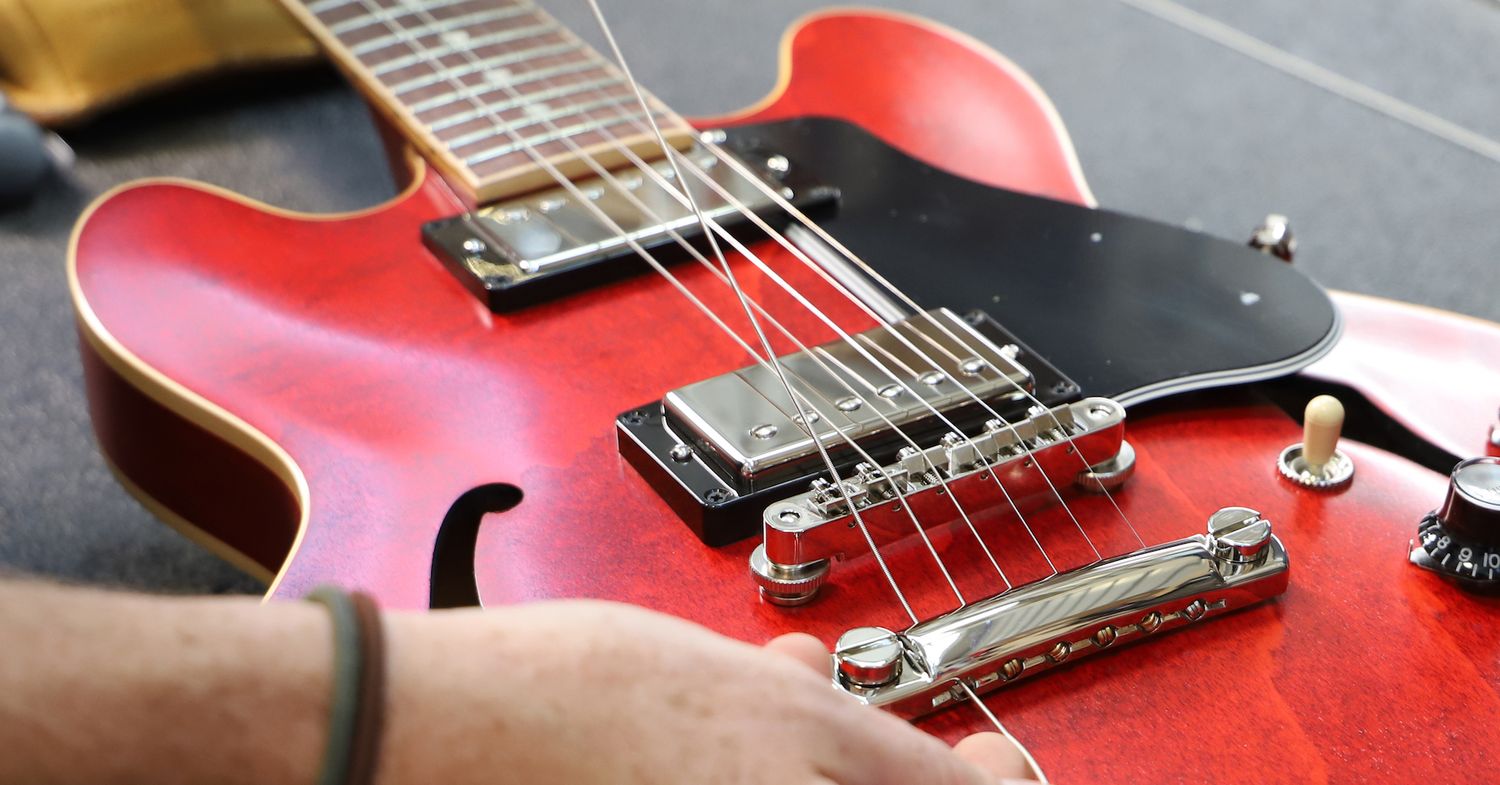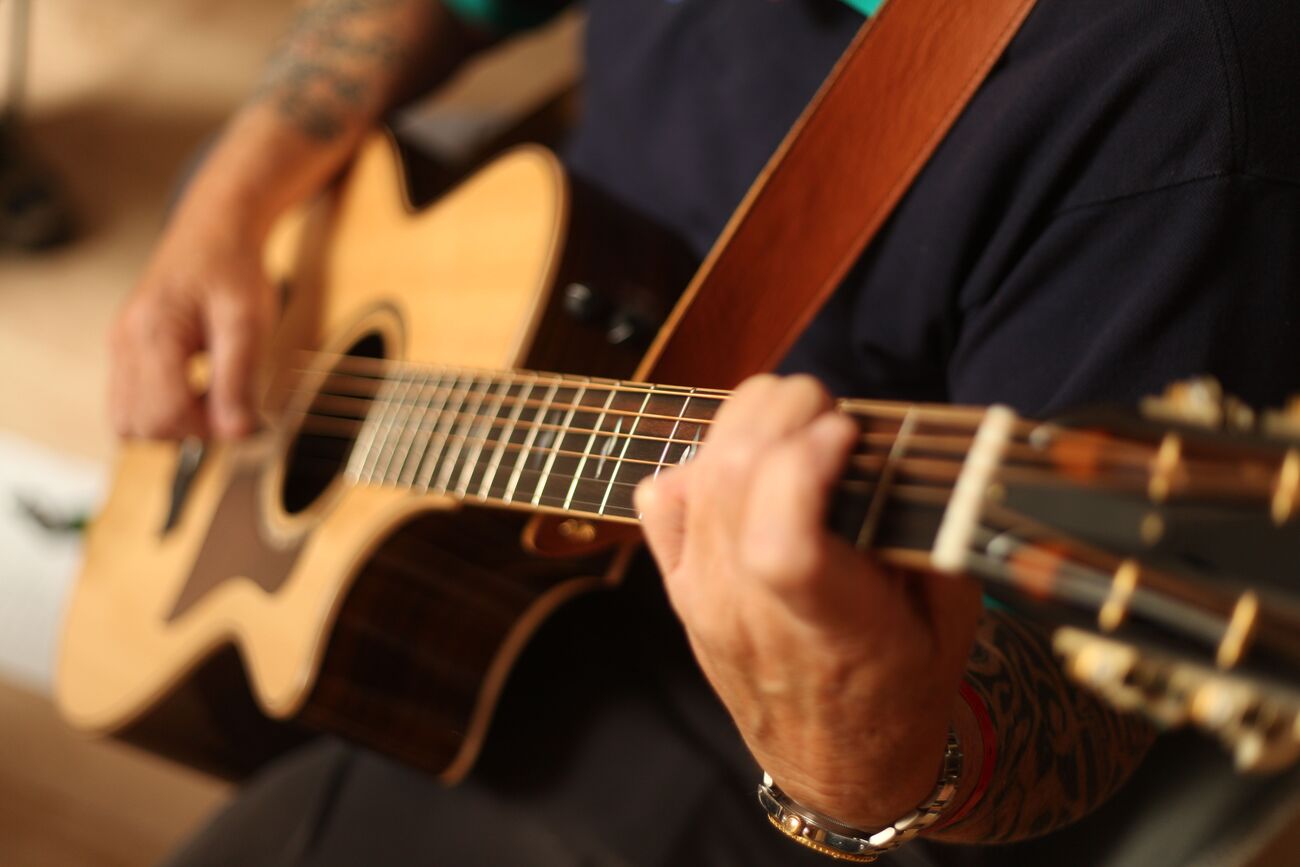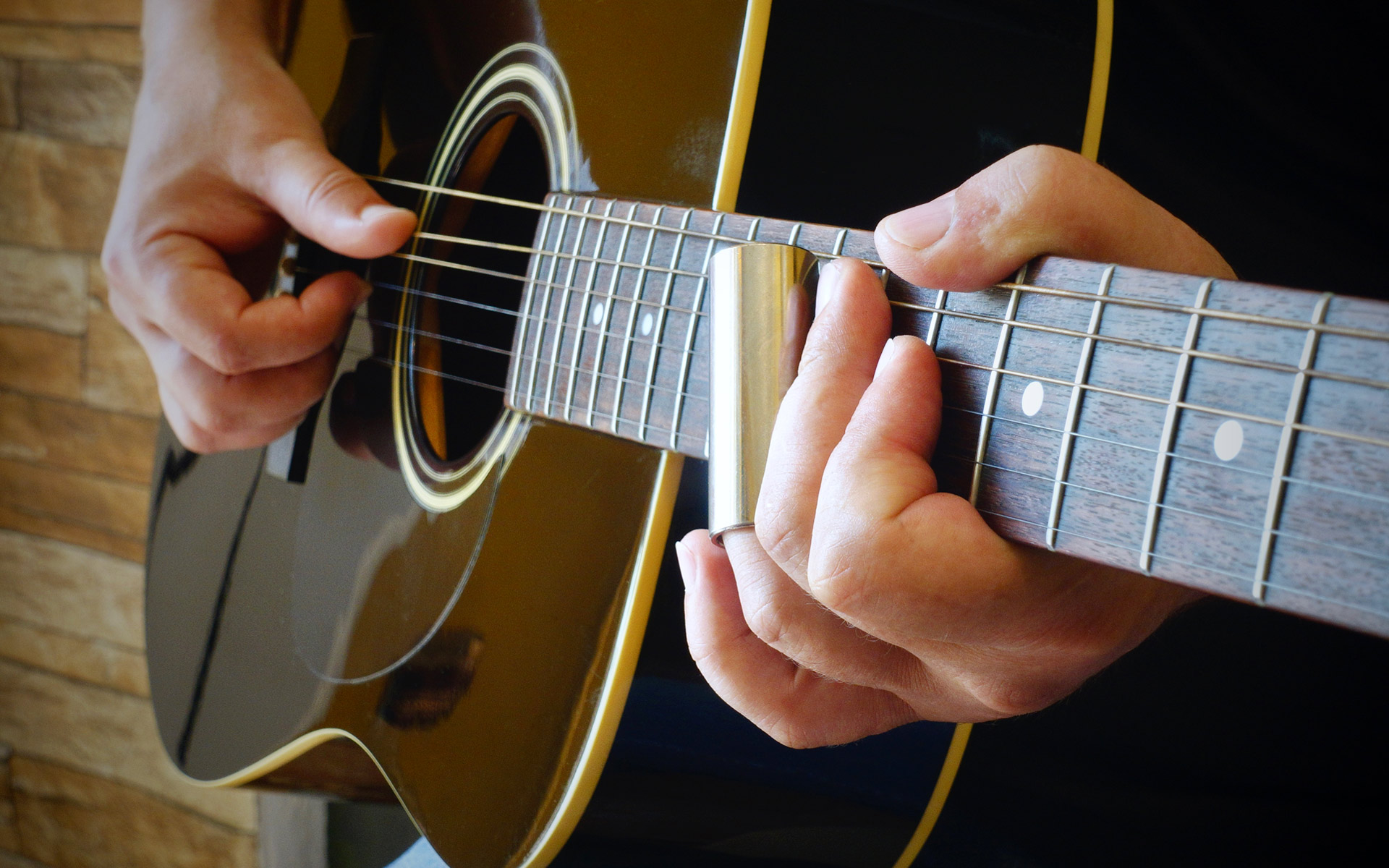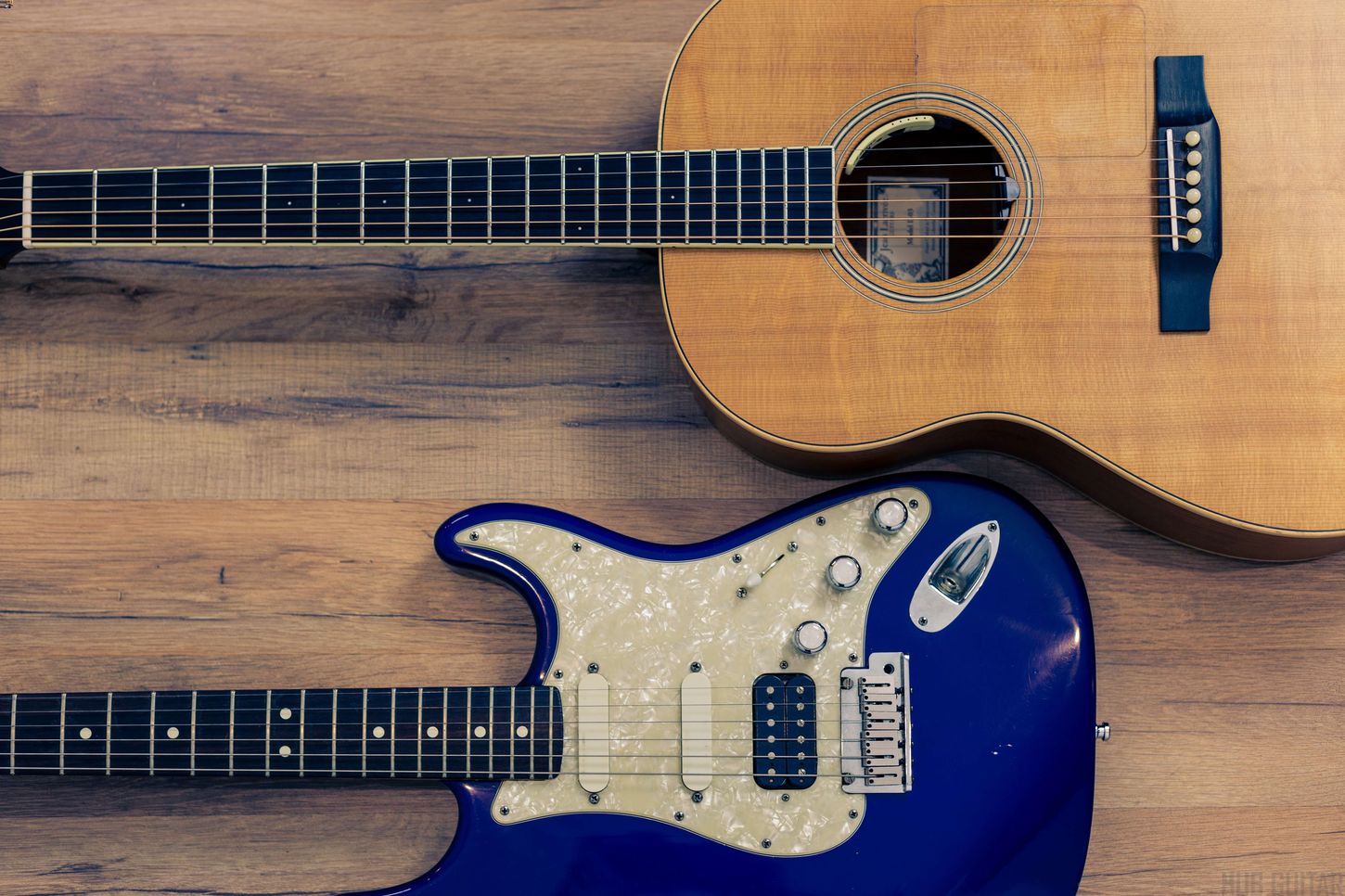Home>Production & Technology>Acoustic>Electric Guitar Or Acoustic Guitar: Which Is Easier To Play


Acoustic
Electric Guitar Or Acoustic Guitar: Which Is Easier To Play
Published: March 11, 2024
Discover the ease of playing acoustic guitar compared to electric guitar. Learn which one suits your playing style and preferences. Explore the differences and find the perfect fit for you.
(Many of the links in this article redirect to a specific reviewed product. Your purchase of these products through affiliate links helps to generate commission for AudioLover.com, at no extra cost. Learn more)
Table of Contents
Introduction
When it comes to learning to play the guitar, one of the first decisions aspiring musicians face is whether to start with an electric guitar or an acoustic guitar. Both instruments have their own unique characteristics and appeal, but they also present different challenges and advantages for beginners. Understanding the differences between the two can help individuals make an informed choice based on their preferences and learning style.
Learning to play the guitar is an exciting journey that opens the door to a world of musical expression and creativity. Whether strumming chords around a campfire or shredding solos on stage, the guitar holds a special place in the hearts of musicians and music enthusiasts alike. However, the choice between an electric guitar and an acoustic guitar can significantly impact the learning experience and skill development of a budding guitarist.
The decision to start with an electric or acoustic guitar often depends on personal musical preferences and the specific genre of music an individual aims to play. While an electric guitar is synonymous with rock, blues, and jazz, an acoustic guitar is commonly associated with folk, country, and singer-songwriter styles. This distinction in musical genres can influence a beginner's choice, as they may be drawn to the sound and aesthetic of a particular guitar type.
Moreover, the physical differences between electric and acoustic guitars also play a crucial role in the decision-making process. The size, weight, and shape of the instruments, as well as the type of strings and the action of the fretboard, all contribute to the unique playing experience offered by each guitar type. Understanding these differences is essential for beginners to make an informed choice that aligns with their musical aspirations and learning goals.
As we delve into the specifics of electric and acoustic guitars, it becomes clear that each instrument has its own set of challenges and advantages for beginners. By exploring the nuances of construction, string tension, finger strength requirements, sound production, and the learning curve associated with each guitar type, individuals can gain valuable insights to guide them in selecting the instrument that best suits their musical journey.
Differences in Construction
The construction of electric and acoustic guitars differs significantly, influencing not only their sound but also their playability. An acoustic guitar is crafted with a hollow body, typically made of wood, which amplifies the sound produced by the vibrating strings. This design allows the acoustic guitar to generate its sound without the need for external amplification, making it a versatile and portable instrument. In contrast, an electric guitar features a solid or semi-hollow body and relies on electronic amplification to produce sound. The pickups on an electric guitar capture the string vibrations and convert them into electrical signals, which are then amplified through an external speaker.
The physical differences in construction also extend to the neck and fretboard of the two guitar types. Acoustic guitars usually have a wider neck and a flat fretboard, which can make it slightly more challenging for beginners with smaller hands to navigate the frets and form chords. On the other hand, electric guitars often have a narrower neck and a curved fretboard, offering a more ergonomic and comfortable playing experience, especially for individuals with smaller hands or those transitioning from playing other string instruments.
Furthermore, the body shape and size of acoustic and electric guitars vary, impacting the overall feel and comfort during play. Acoustic guitars tend to have a larger, more rounded body, which may require some adjustment in posture and playing technique, particularly for individuals accustomed to smaller instruments. Electric guitars, with their sleek and often more compact bodies, offer a lighter and more maneuverable option, making them appealing for those seeking a guitar that is easier to handle, especially during extended practice sessions or live performances.
In summary, the construction disparities between electric and acoustic guitars encompass the body type, neck width, and fretboard design, all of which contribute to distinct playing experiences. Understanding these differences is crucial for beginners as they weigh the physical attributes and ergonomic considerations that align with their comfort and playing style. Whether drawn to the resonance of an acoustic guitar or the versatility of an electric guitar, aspiring musicians can make an informed decision based on their preferences and the unique construction features of each instrument.
String Tension and Action
String tension and action play a pivotal role in shaping the playing experience and technical demands of both electric and acoustic guitars. Understanding these aspects is essential for beginners as they navigate the nuances of each instrument.
Acoustic guitars are known for their higher string tension, which refers to the force exerted by the strings against the frets and the guitar's bridge. The higher tension in acoustic guitar strings requires more finger strength to press down on the frets and produce clear notes and chords. This can pose a challenge for beginners, especially those who are still developing finger strength and dexterity. Additionally, the action of an acoustic guitar, which refers to the distance between the strings and the fretboard, tends to be higher compared to electric guitars. A higher action can make fretting notes and forming chords more physically demanding, as it requires greater finger pressure and precision to avoid buzzing or muted notes.
In contrast, electric guitars are characterized by lower string tension and typically have a lower action, making them more forgiving and easier to play, especially for beginners. The reduced string tension on electric guitars allows for smoother string bending and fretting, requiring less finger strength to produce clear notes and chords. The lower action also contributes to a more comfortable playing experience, as it facilitates faster fretting and minimizes finger fatigue during prolonged practice sessions.
The differences in string tension and action between electric and acoustic guitars directly impact the technical demands placed on beginners. While acoustic guitars demand greater finger strength and precision due to higher string tension and action, electric guitars offer a more accessible playing experience, making it easier for beginners to fret notes and form chords with less physical exertion.
Ultimately, the string tension and action of a guitar are crucial considerations for beginners as they evaluate the technical challenges and physical demands associated with each instrument. By understanding these differences, aspiring guitarists can make an informed decision based on their comfort level, finger strength, and the playing experience they seek to achieve. Whether drawn to the raw resonance of an acoustic guitar or the effortless playability of an electric guitar, individuals can align their choice with their learning goals and musical aspirations.
Finger Strength and Dexterity
Finger strength and dexterity are fundamental attributes that significantly influence a guitarist's ability to navigate the fretboard, form chords, and execute intricate playing techniques. When comparing the demands placed on finger strength and dexterity between electric and acoustic guitars, distinct considerations come to light, shaping the learning experience for beginners.
Acoustic guitars, with their higher string tension and often wider necks, necessitate a greater degree of finger strength to produce clear and resonant notes. The substantial force required to press down on the strings against the frets demands diligent finger conditioning and development. As beginners embark on their guitar journey, they may find themselves challenged by the initial discomfort and fatigue associated with building the necessary finger strength to effectively fret chords and execute melodic passages on an acoustic guitar. Furthermore, the broader neck and flat fretboard of acoustic guitars can pose dexterity challenges, especially for individuals with smaller hands, as they navigate the frets and transition between chords.
In contrast, electric guitars offer a more forgiving landscape for finger strength and dexterity development. The lower string tension and narrower necks of electric guitars reduce the physical exertion needed to fret notes and form chords, providing beginners with a gentler introduction to building finger strength and dexterity. The curved fretboard design of electric guitars also contributes to a more ergonomic and accessible playing experience, allowing for smoother transitions between chords and facilitating the development of nimble finger movements.
As beginners progress in their guitar journey, the demands on finger strength and dexterity evolve, presenting unique challenges and opportunities for growth. Acoustic guitarists may find that the initial hurdles of building finger strength and dexterity translate into enhanced finger control and precision, enabling them to produce rich, resonant tones and execute dynamic playing techniques. On the other hand, electric guitarists, while benefiting from a smoother entry into fretting and chord formation, must continually refine their finger dexterity to master intricate lead guitar solos and expressive phrasing.
In essence, the interplay between finger strength and dexterity in the context of acoustic and electric guitars underscores the diverse pathways through which beginners can cultivate their technical prowess and musical expression. By recognizing the distinct demands and developmental trajectories associated with each instrument, aspiring guitarists can make an informed choice that aligns with their physical capabilities, learning preferences, and long-term musical aspirations. Whether drawn to the raw, unadulterated resonance of an acoustic guitar or the versatile, expressive realm of an electric guitar, individuals can embark on their guitar journey with a clear understanding of the finger strength and dexterity considerations that shape their path to musical proficiency.
Sound Production
The aspect of sound production stands as a defining feature that sets electric and acoustic guitars apart, shaping the tonal characteristics and sonic capabilities of each instrument. Understanding the nuances of sound production is essential for beginners as they embark on their guitar journey, as it directly influences the expressive potential and musical versatility offered by electric and acoustic guitars.
Acoustic guitars, with their hollow bodies and sound chambers, produce sound acoustically, relying on the resonance and amplification of the instrument itself. The vibrations of the steel or nylon strings resonate through the body of the guitar, creating warm, natural tones that are rich in harmonics and depth. This acoustic projection lends itself to a dynamic and expressive playing experience, allowing guitarists to evoke a wide range of emotions and moods through the instrument's organic sound. The acoustic guitar's ability to fill a space with its resonant timbre makes it a popular choice for intimate performances, songwriting sessions, and unplugged musical settings.
In contrast, electric guitars rely on electronic amplification to produce and shape their sound. The pickups, often positioned near the guitar's bridge and neck, capture the string vibrations and convert them into electrical signals, which are then processed and amplified through an external amplifier. This process allows for a greater degree of tonal manipulation and control, as electric guitarists can experiment with various effects, such as distortion, reverb, and modulation, to craft a diverse sonic palette. The amplified sound of an electric guitar offers a powerful and versatile canvas for musicians to explore genres ranging from rock and blues to jazz and beyond, making it a staple in the realm of amplified music and live performances.
Furthermore, the tonal characteristics of acoustic and electric guitars influence the playing techniques and musical styles favored by guitarists. Acoustic guitars, with their natural resonance and dynamic range, lend themselves to fingerstyle playing, intricate arpeggios, and rhythmic strumming, making them well-suited for folk, country, and singer-songwriter genres. On the other hand, the amplified sound and tonal versatility of electric guitars cater to lead guitar solos, power chords, and expressive bends, aligning with the demands of rock, metal, and fusion styles.
In essence, the distinct modes of sound production offered by electric and acoustic guitars present aspiring musicians with a choice that extends beyond physical attributes and technical demands. The acoustic guitar's acoustic projection and natural resonance evoke a timeless and authentic quality, while the electric guitar's amplified sound and tonal flexibility open doors to boundless sonic exploration. By recognizing the impact of sound production on musical expression and genre preferences, beginners can make an informed decision that resonates with their artistic vision and sonic aspirations, setting the stage for a fulfilling and enriching guitar journey.
Learning Curve
The learning curve associated with mastering the guitar is a pivotal consideration for beginners as they embark on their musical journey. When comparing the learning curves of electric and acoustic guitars, distinct pathways to proficiency and musical expression come to light, shaping the experiences and skill development of aspiring guitarists.
Acoustic guitars, with their higher string tension and demanding finger strength requirements, present a steep initial learning curve for beginners. The physical exertion needed to fret chords and produce clear notes can pose a formidable challenge, especially for individuals who are still building finger strength and dexterity. Additionally, the broader neck and flat fretboard of acoustic guitars may require a period of adjustment for beginners, as they familiarize themselves with the instrument's ergonomic nuances. However, as beginners persist and overcome these initial hurdles, they often find that the acoustic guitar's demanding nature translates into enhanced finger control, precision, and dynamic playing techniques. This gradual mastery fosters a deep sense of accomplishment and sets the stage for expressive musical exploration.
On the other hand, electric guitars offer a more accessible learning curve for beginners, owing to their lower string tension and ergonomic design. The reduced physical exertion required to fret notes and form chords provides a gentler introduction to the technical aspects of guitar playing, allowing beginners to focus on developing fundamental skills and playing techniques. The forgiving nature of electric guitars facilitates a smoother transition into the world of fretting, strumming, and picking, empowering beginners to progress at a comfortable pace and build confidence in their musical abilities. As beginners delve into the realm of electric guitar playing, they discover the instrument's versatility and expressive potential, paving the way for creative exploration and stylistic diversity.
The distinct learning curves of electric and acoustic guitars underscore the diverse pathways through which beginners can cultivate their musical proficiency and artistic expression. While the acoustic guitar's initial challenges lead to refined finger control and dynamic playing, the electric guitar's accessible nature fosters confidence and paves the way for versatile musical exploration. By recognizing the unique learning trajectories associated with each instrument, aspiring guitarists can make an informed choice that aligns with their learning preferences, musical aspirations, and long-term growth as musicians.
Conclusion
In the realm of guitar playing, the choice between an electric guitar and an acoustic guitar holds profound implications for beginners, shaping their learning experience, technical development, and musical expression. As aspiring guitarists weigh the decision, it becomes evident that each instrument offers a distinct set of challenges and advantages, catering to diverse musical aspirations and learning preferences.
The acoustic guitar, with its resonant sound production and demanding physical attributes, presents a formidable yet rewarding path for beginners. The higher string tension, wider neck, and acoustic projection of the instrument demand diligent finger strength and precision, fostering a journey of resilience and technical mastery. As beginners navigate the initial learning curve and overcome the physical challenges, they discover the acoustic guitar's timeless allure and expressive potential, paving the way for intimate performances, soulful songwriting, and dynamic fingerstyle playing.
Conversely, the electric guitar beckons beginners with its accessible playing experience and tonal versatility. The lower string tension, ergonomic design, and amplified sound production offer a gentler entry into the world of guitar playing, empowering beginners to explore diverse playing techniques and musical styles. As beginners harness the expressive potential of the electric guitar, they embark on a journey of sonic exploration, from emotive lead guitar solos to powerful rhythm playing, embracing the instrument's boundless creative possibilities.
Ultimately, the choice between an electric guitar and an acoustic guitar transcends technical considerations, resonating with the artistic vision and musical aspirations of each individual. Whether drawn to the raw resonance of an acoustic guitar or the amplified versatility of an electric guitar, beginners embark on a transformative journey shaped by the instrument they choose. As they navigate the nuances of construction, string tension, finger strength, sound production, and the learning curve, aspiring guitarists gain valuable insights that guide them toward an instrument that aligns with their musical journey and fuels their passion for creative expression.
In the tapestry of musical exploration, the guitar stands as a timeless symbol of artistic expression and emotional resonance. Whether strumming the chords of a heartfelt ballad on an acoustic guitar or unleashing searing riffs on an electric guitar, beginners embark on a journey that transcends technical proficiency, embracing the instrument that resonates with their soul and fuels their musical odyssey. As the strings resonate and the melodies unfold, the choice between an electric guitar and an acoustic guitar becomes a deeply personal and transformative decision, setting the stage for a lifelong pursuit of musical excellence and creative fulfillment.











